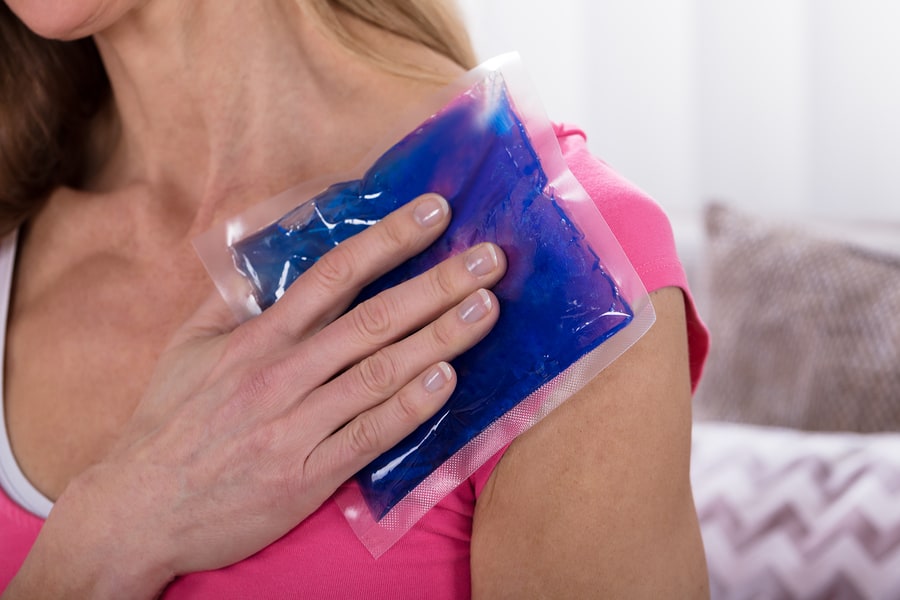
Most sport-health practices use water as first aid whenever an athlete gets injured. Ordinary water has little effect, so iced water is a better option. Aside from ice water packs, there is something more similar, known as gel ice packs. While ice water and gel ice packs are identical, they differ slightly. Gel ice packs are portable bags filled with water and refrigerant gel to cool and relieve the applied body part.
Gel ice packs work on internal injuries that do not involve body scarring. Gel ice packs seem basic and easy to use, but their mechanism of action is quite complex. This article will discuss how gel ice packs provide relief when applied to an injured body part.
Methods of Relief:
Gel Ice Packs work marvelously beyond placing the pack on the injured part. It is highly recommended as a means of first aid because of its mechanism of action. Below are ways gel ice packs work on an injured area:
Temperature Regulation
As mentioned, ice packs are used on internal injuries, not open scarred ones. Excess heat on injuries can cause discomfort and exacerbate internal bleeding. Cold mechanisms like gel pack therapy will help to constrict the blood vessels and reduce bleeding. If temperature is not regulated, heat can result in inflammation of the injury and increase pain.
The gel inside the pack absorbs heat, and heat conduction occurs. As the gel becomes warm, the area of the injury becomes cool. The gel pack returns to a solid state of matter after a while and releases free energy. This cycle that the gel pack undergoes helps regulate the area's temperature.
Numbing Effect of Pain Receptors
Pain is a primary characteristic of injuries. However, gel ice packs have a numbing effect that helps to reduce the pain drastically. The cold temperature of gel ice packs tends to reduce nerve activity. When the nerves have reduced activity, they cannot send signals to the part of the brain that alerts you of pain. Hence, cold therapies like gel ice packs help alleviate the injury's painful sensation.
Reduction of Inflammation
Dilation of blood vessels occurs when a part of the body is injured. The wider the blood vessels become, the more blood flows out of the blood vessels, resulting in swelling and inflammation. Reduction of Inflammation by gel ice packs is closely related to the effect of temperature. That is when the temperature of the affected area is reduced by cold therapy, the blood vessels constrict and become thinner. The thinner it becomes, the less the loss of blood. Which subsequently results in reduced inflammation and swelling of the affected area.
Reduction of Tissue Damage
There are different forms of injuries. It might affect the bones or the muscles. However, whatever it destroys is made of tissues and cells. Injuries vary according to certain degrees and can escalate if not treated properly. Cold therapies help to slow down the metabolism of the affected tissues.
That is, injuries will result in increased temperature of the affected area. The temperature rise will result in increased metabolism. Increased metabolism means the tissues will work harder than average and quickly break down. Hence, using cold therapies has a reverse effect of heat and helps reduce the risk of further tissue damage.
Muscle Relaxation
When the injury affects a muscle, gel ice packs can help to facilitate muscle relaxation. Muscle sprain and strains result in increased muscle spasms, which results in pain in the affected area and tissue damage. Cold therapies help to reduce muscle spasms and contractions of the muscles.
Generally, Gel ice packs have an interrelated effect on injuries. The reduction of temperature in the affected tissues leads to a series of events that help to serve as a means of first aid to athletes. It should always be in the first aid kit before immediate attention is given to the injured athlete in the hospital.
Type of Gel Ice Packs:
Gel Ice packs come in various ways. Familiarization with the classification will help when you need to make a purchase. Below are three major types of Gel Ice Packs:
Reusable vs Disposable
Gel Ice Packs come in two forms regarding the mode of use. Some can be reused, while others are designed for one-time purposes. Reusable gel ice packs are made of durable materials that can withstand temperature change and will not reduce their quality. They are generally environmentally friendly and cost-effective. On the other hand, disposable gel ice packs are used in situations where hygiene is paramount. That is, the injury is so delicate, and reusing an ice pack is not the best thing to do.
Shapes and Sizes
Most items, like gel ice packs, come in various sizes and shapes. There are different types, like the large rectangular-shaped packs or the wrap-round packs. Rectangular gel ice packs usually arrive in large sizes. They are very versatile and can be used for most body parts. Meanwhile, small bags that can fit into a fist are used for localized treatment. This implies that such packs are applied directly to the specific injured area. Wrap-round gel packs also come in various forms. They are made to fit the multiple contours of the body while providing relief.
Specialized Packs
As mentioned earlier, some gel ice packs are small or round to fit various body parts. The anatomy of the body differs in multiple ways. For example, gel ice packs for necks will be tailored and more effective for that body area. The effect will be slower if the specialized neck gel ice packs are used on the arm.
The type of Gel Ice Packs to purchase depends on the frequent place an injury occurs in a specific sport. Generally, reusable gel ice packs should always be available because of their versatility. Whatever gel ice packs you intend to purchase can be obtained from our e-shop or nearby pharmacies at quite affordable rates.
Importance of Gel Ice Packs:
In the interwoven world of sports and health, gel ice packs are a huge relief in both sectors. Below are the importance of gel ice packs:
- Gel packs are used for immediate recovery of minute injuries during sports events.
- Gel Ice Packs help to prevent internal bleeding in 1st degree injuries.
- They help to facilitate faster recovery in the injured athlete.
- They help to prevent secondary tissue damage.
- If athletes undergo surgery, it is a post-operative therapy to hasten recovery.
- It is used in managing health issues that involve the joints, like arthritis.
Proper Usage:
You should consider the points below while using gel packs to prevent frostbites:
#1 Applying the pack for 15-20 minutes at a time with intervals is essential. The interval application of the gel ice packs allows the body part to warm up for a while before the therapy continues.
#2 The first 48 hours of usage is when the benefits of the therapy are practical. If you continue with the therapy after 48 hours without getting proper treatment, it will result in adverse effects. These negative effects counter the entire purpose of using the gel ice packs in the first place.
#3 Always use a light towel or cloth between the gel ice packs and the skin. This avoids direct contact of the skin with the cold gel packs and inhibits skin damage and frostbites.
#4 Check the skin regularly for redness and excessive numbness. If this is noticed, stop the therapy immediately, as further usage will result in uncontrollable skin damage.
#5 In rare cases, you should combine and alternate cold and heat therapies. This is known as contrast therapy. However, before proceeding with such a procedure, contact a healthcare professional.
Taking precautions and using the proper methods will help to facilitate healing and prevent further damage to the injured area and the skin around it.
Gel Ice Packs vs Ice Bath
Ice baths are also a common form of cold therapy. However, there are a lot of differences between both of them. This implies that the type of injury and the location at which it occurs must be considered before choosing the type of therapy to carry out. In the long run, Gel Ice Packs have specific healing treatments and can easily be monitored compared to Ice baths. Gel ice packs are a more suitable and efficient cold therapy than other types.
Conclusion
Whenever an injury occurs, taking the person to the nearest hospital for immediate and accurate treatment is essential. Nonetheless, gel ice packs can provide first aid and even post-treatment therapy to improve healing.
The mechanism of gel ice packs is interwoven, but they ensure that the person's injured part is restored to normal after a while of adequate treatment. Looking after the injured area during and after healing is also essential to guarantee a good healing process.



